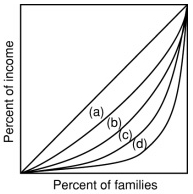 |
| 1 |  | 
Use the following diagram to answer the question. <a onClick="window.open('/olcweb/cgi/pluginpop.cgi?it=jpg::::/sites/dl/free/0073511455/991476/webb_q1.jpg','popWin', 'width=NaN,height=NaN,resizable,scrollbars');" href="#"><img valign="absmiddle" height="16" width="16" border="0" src="/olcweb/styles/shared/linkicons/image.gif"> (20.0K)</a> <a onClick="window.open('/olcweb/cgi/pluginpop.cgi?it=jpg::::/sites/dl/free/0073511455/991476/webb_q1.jpg','popWin', 'width=NaN,height=NaN,resizable,scrollbars');" href="#"><img valign="absmiddle" height="16" width="16" border="0" src="/olcweb/styles/shared/linkicons/image.gif"> (20.0K)</a>
Refer to the diagram. The curves (a) through (d) shown in the diagram are known as: |
|  | A) | income curves. |
|  | B) | Gini curves. |
|  | C) | Lorenz curves. |
|  | D) | level curves. |
|
|
 |
| 2 |  | 
Regarding the effect of taxes and transfer payments on the U.S. income distribution, data indicate that: |
|  | A) | there is virtually no impact. |
|  | B) | the progressive tax system accounts for over half of the reduction in income inequality. |
|  | C) | tax rebates and credits account for over half of the income of those in the lowest quintile. |
|  | D) | roughly 80 percent of the reduction in income inequality is attributable to transfer payments. |
|
|
 |
| 3 |  | 
Compared to annual incomes, lifetime incomes are: |
|  | A) | more equally distributed, reflecting substantial income mobility. |
|  | B) | less equally distributed, reflecting substantial income mobility. |
|  | C) | less equally distributed, reflecting very little income mobility. |
|  | D) | distributed about the same, reflecting very little income mobility. |
|
|
 |
| 4 |  | 
Which of the following would support an argument for redistribution of income from the rich to the poor? |
|  | A) | Diminishing marginal utility of income |
|  | B) | Differences in incomes providing incentives to work |
|  | C) | Diminishing total utility of income |
|  | D) | The equality-efficiency trade-off |
|
|
 |
| 5 |  | 
Use the following diagram to answer the question. <a onClick="window.open('/olcweb/cgi/pluginpop.cgi?it=jpg::::/sites/dl/free/0073511455/991476/webb_q5.jpg','popWin', 'width=NaN,height=NaN,resizable,scrollbars');" href="#"><img valign="absmiddle" height="16" width="16" border="0" src="/olcweb/styles/shared/linkicons/image.gif"> (19.0K)</a> <a onClick="window.open('/olcweb/cgi/pluginpop.cgi?it=jpg::::/sites/dl/free/0073511455/991476/webb_q5.jpg','popWin', 'width=NaN,height=NaN,resizable,scrollbars');" href="#"><img valign="absmiddle" height="16" width="16" border="0" src="/olcweb/styles/shared/linkicons/image.gif"> (19.0K)</a>
Refer to the diagram. Which of the Lorenz curves in the diagram corresponds to the largest Gini ratio? |
|  | A) | A |
|  | B) | B |
|  | C) | C |
|  | D) | D |
|
|
 |
| 6 |  | 
The degree of income inequality in the income distribution can be measured by the: |
|  | A) | Phillips index. |
|  | B) | income deflator. |
|  | C) | Census Bureau Index. |
|  | D) | Gini ratio. |
|
|
 |
| 7 |  | 
All of the following have contributed to increased income inequality since 1969 except: |
|  | A) | a reduction in immigration. |
|  | B) | an increase in the demand for skilled workers. |
|  | C) | an increase in international competition. |
|  | D) | an increase in the number of families headed by single or divorced women. |
|
|
 |
| 8 |  | 
Since 1970, the U.S. distribution of income has: |
|  | A) | remained essentially the same, although the distribution of wealth has become substantially more unequal. |
|  | B) | exhibited a substantial decrease in income mobility. |
|  | C) | showed a movement away from inequality due to the falling returns from education. |
|  | D) | become more unequal because of increased demand for highly skilled workers. |
|
|
 |
| 9 |  | 
What is the difference between social insurance programs and public assistance programs? |
|  | A) | Social insurance programs provide only cash benefits; public assistance programs provide only noncash transfers. |
|  | B) | Social insurance program payments go primarily to those who paid for them through payroll taxes; public assistance payments come out of general tax revenues and are regarded as public charity. |
|  | C) | Public assistance payments go primarily to those who paid for them through payroll taxes; social insurance program payments come out of general tax revenues and are regarded as public charity. |
|  | D) | There is no difference between the two; they are simply different names for the same program. |
|
|
 |
| 10 |  | 
Use the following diagram to answer the question. <a onClick="window.open('/olcweb/cgi/pluginpop.cgi?it=jpg::::/sites/dl/free/0073511455/991476/webb_q10.jpg','popWin', 'width=NaN,height=NaN,resizable,scrollbars');" href="#"><img valign="absmiddle" height="16" width="16" border="0" src="/olcweb/styles/shared/linkicons/image.gif"> (19.0K)</a> <a onClick="window.open('/olcweb/cgi/pluginpop.cgi?it=jpg::::/sites/dl/free/0073511455/991476/webb_q10.jpg','popWin', 'width=NaN,height=NaN,resizable,scrollbars');" href="#"><img valign="absmiddle" height="16" width="16" border="0" src="/olcweb/styles/shared/linkicons/image.gif"> (19.0K)</a>
Refer to the diagram. Suppose the economy's income distribution is represented by line b. An increase in income inequality would be represented by a movement: |
|  | A) | to line a. |
|  | B) | up and to the right along line b. |
|  | C) | to line c. |
|  | D) | down and to the left along line b. |
|
|

